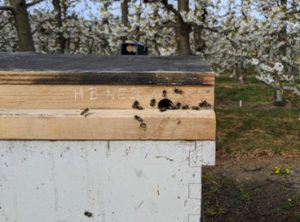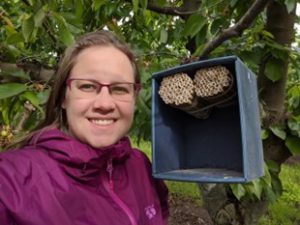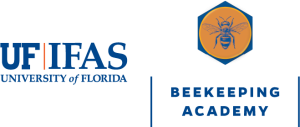Honey Bee Heat Warms Up Fellow Pollinators for Early-Season Blooms

An incubator that draws excess heat from a honey bee hive warms up managed Osmia lignaria bees so they can pollinate early-blooming fruit trees such as cherry, apple, and almond. A new study shows the hivetop incubators are effective, with little effect on the honey bee hive temps below. Shown here is a hivetop incubator atop a honey bee hive, with a small exit hole from which O. lignaria bees can be seen emerging.
By Paige Embry
Honey bees (Apis mellifera) are the go-to pollinator for early-blooming fruit trees like cherries, apples, and almonds, but they aren’t the best pollinator for these crops. That title belongs to Osmia lignaria, often known as the blue orchard bee or BOB.
In the chilly days of early spring, BOBs fly more hours than honey bees and go out when it’s colder. They carry pollen, dry, in hairs on the underside of their abdomen where it may easily rub off when they flop into flowers, while honey bees carry pollen in tidy packets on their hind legs. BOBs are also flitters, moving from tree to tree rather than just working one plant like a honey bee often does—promoting the cross-pollination needed for some of these trees.

Lindsie McCabe, Ph.D., is a postdoctoral fellow with the U.S. Department of Agriculture’s Agricultural Research Service who led a recent study on practices for deploying Osmia lignaria bees for pollination in orchards. Here, McCabe pauses next to a O. lignaria nest box during the season after bloom and bee foraging. In the next box, tunnels with “mud caps” are nests filled with immature O. lignaria bees.
Lindsie McCabe, Ph.D., a postdoctoral fellow with the U.S. Department of Agriculture’s Agricultural Research Service, says, “Honey bees are very, very methodical in how they collect pollen, and blue orchard bees are just like, ‘I’m going to get all into this flower and rub it everywhere.’” What that behavior means is that several hundred female BOBs can pollinate an acre of early fruit as effectively as thousands of honey bees.
Part of the reason honey bees continue to dominate is that how to use them is well-established, while how to use BOBs is still a work in progress. A study published last week in the Journal of Economic Entomology focuses on a way to streamline one aspect of blue orchard bee management—waking them up from their winter’s sleep.
BOBs spend the winter as adults in cocoons in a hibernation-like state called diapause. Managed BOB cocoons are kept in cold storage and need to be warmed up before the bees will emerge. An easy, standardized way to do that hasn’t been developed. For example, one grower warmed the bees in her house. Two days usually worked, but when they wouldn’t rouse one year she stuck them in the bathroom with a space heater set to 85 degrees Fahrenheit. It worked, but bees in the house seems like an unlikely method to promote widespread BOB use.
Plus, any method of warming bees inside means they are then thrust out into the cold. “This can cause a problem sometimes,” says McCabe, “especially when you get cold snaps in the orchard or in the western U.S. when it gets really cold at night. … It seems to take them longer to emerge when they don’t have heat below them.”
To read the complete article go to; Honey Bee Heat Warms Up Fellow Pollinators for Early-Season Blooms (entomologytoday.org)
We are here to share current happenings in the bee industry. Bee Culture gathers and shares articles published by outside sources. For more information about this specific article, please visit the original publish source: Honey Bee Heat Warms Up Fellow Pollinators for Early-Season Blooms (entomologytoday.org)








